There’s hardly a thing that impacts your software-as-a-service product revenue more than SaaS pricing models. Still, for many companies, choosing the right monetization strategy is no easy feat.
To shed some light on this matter, we have prepared a detailed guide on the most popular pricing strategies when it comes to building a SaaS product. You will find out the pros and cons of each option and learn how to adopt them properly from well-known SaaS companies. Finally, we will discuss the required steps to take when choosing between different SaaS business models.
What is a SaaS pricing model?
In layman’s terms, a SaaS price model is a method companies use to set the best price for their cloud product or service.
Your main task is to discover the proper balance between value and revenue. On the one side, you want to help customers with your product. On the other side, you expect to get fair compensation for that help. The right balance will help you establish a stable and profitable SaaS business.
When picking the best pricing model for SaaS, factors you need to consider fall under two distinct categories:
- Internal: revenue goals, brand positioning, target audience;
- External: consumer demand, competitor price, overall market trends.
Why is a suitable pricing strategy important?
We all know that the right revenue model is crucial for the SaaS industry. What about specific reasons for its paramount importance? Why do you need to optimize your prices instead of setting them on instinct once and for all?
It helps gain the upper hand
There is a chance that other companies will also find SaaS pricing models challenging. They may be hesitant to optimize their SaaS business models for the same reasons as you are. Still, the right pricing is what will help you stand out from the competitors offering similar products.
You can offer customers true value
Consumers like to buy products that can be easily justified. They want to consider their purchases as wise investments. By setting the SaaS price that users are ready to pay, make the real value of your product your top priority.
It helps strengthen the unit economics
Basically, the success of your SaaS business hinges on the right balance between two key metrics. These are customer lifetime value (CLV) and customer acquisition cost (CAC). The first metric should be significantly higher than the second one. Otherwise, you will not see any growth.
With the optimal pricing model for SaaS, you can kill two birds with one stone. Better positioning can reduce customer acquisition cost, and improved retention can increase customer lifetime value.
Why building a SaaS product can be a good idea
Statista research states that SaaS end-user spending worldwide grew from $31,4 bln in 2015 to $206 bln in 2023 and can grow to almost $300 bln by 2025.
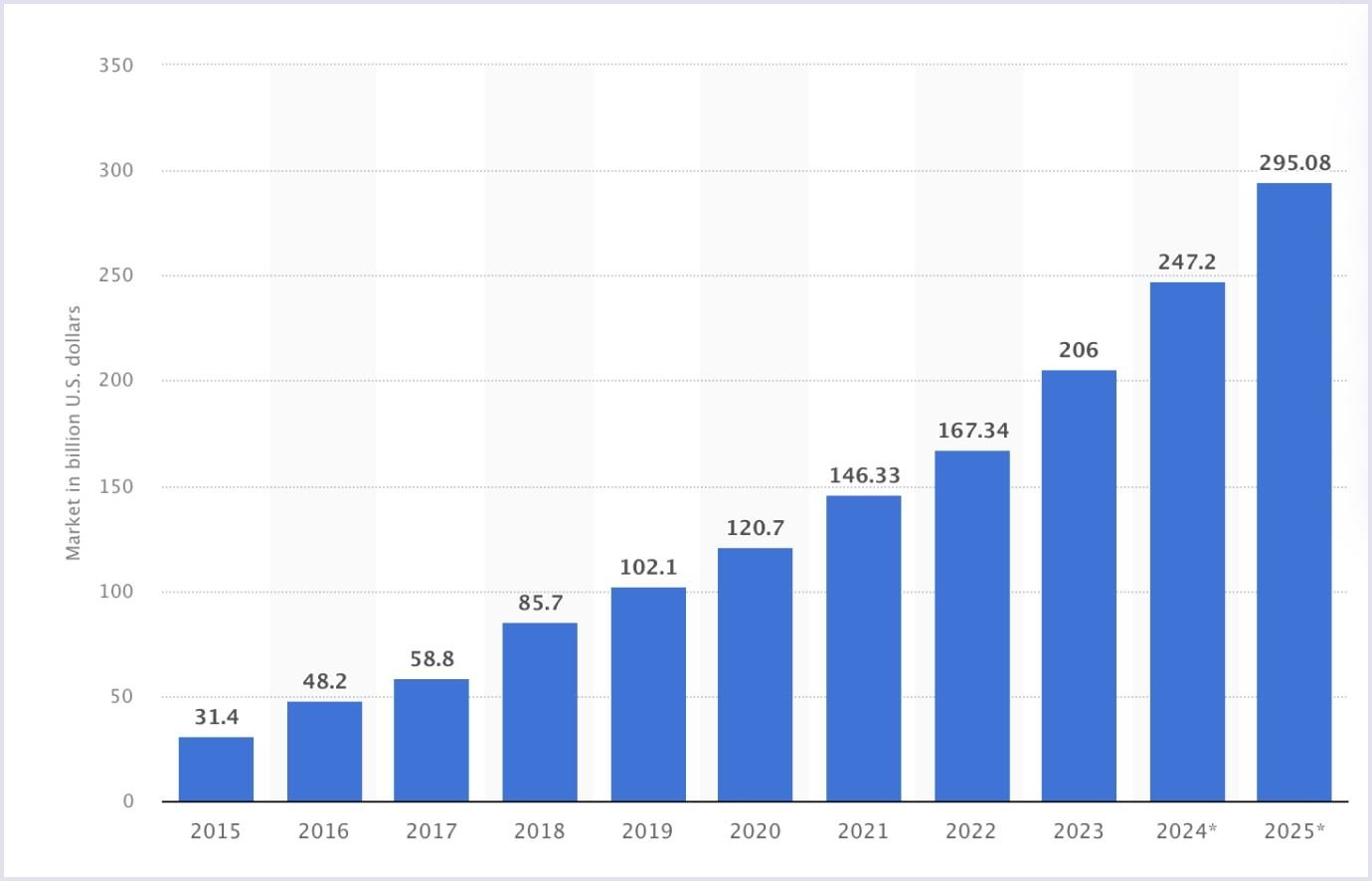
Source: Statista
Sounds impressive, right? 2025 is indeed an excellent time to invest in SaaS development services.
Further reading: How to Calculate the Cost to Build a SaaS App in 2025?
Top 10 SaaS pricing models
Below, you can see the most popular SaaS pricing strategies. Consider each option carefully to make the right choice. Thus, you will be able to get lots of loyal customers and make your business thrive.
Per-user pricing
With this model, you charge customers based on the number of people using your product. Per-user SaaS pricing is popular among project management software, custom relationship management products (CRM), and other team-oriented tools.
Pros
- The SaaS pricing model is pretty simple for customers.
- It makes it easier for you to calculate and forecast the revenue per month.
- Your revenue grows along with the adoption of your product.
Cons
- Large companies and enterprises with lots of users can find this SaaS model pricing too expensive.
- Customers may abandon your services much faster.
- This revenue model does not reflect the actual value of the SaaS product.
Below, you can see the per-user SaaS price model adopted by project management platform Asana:
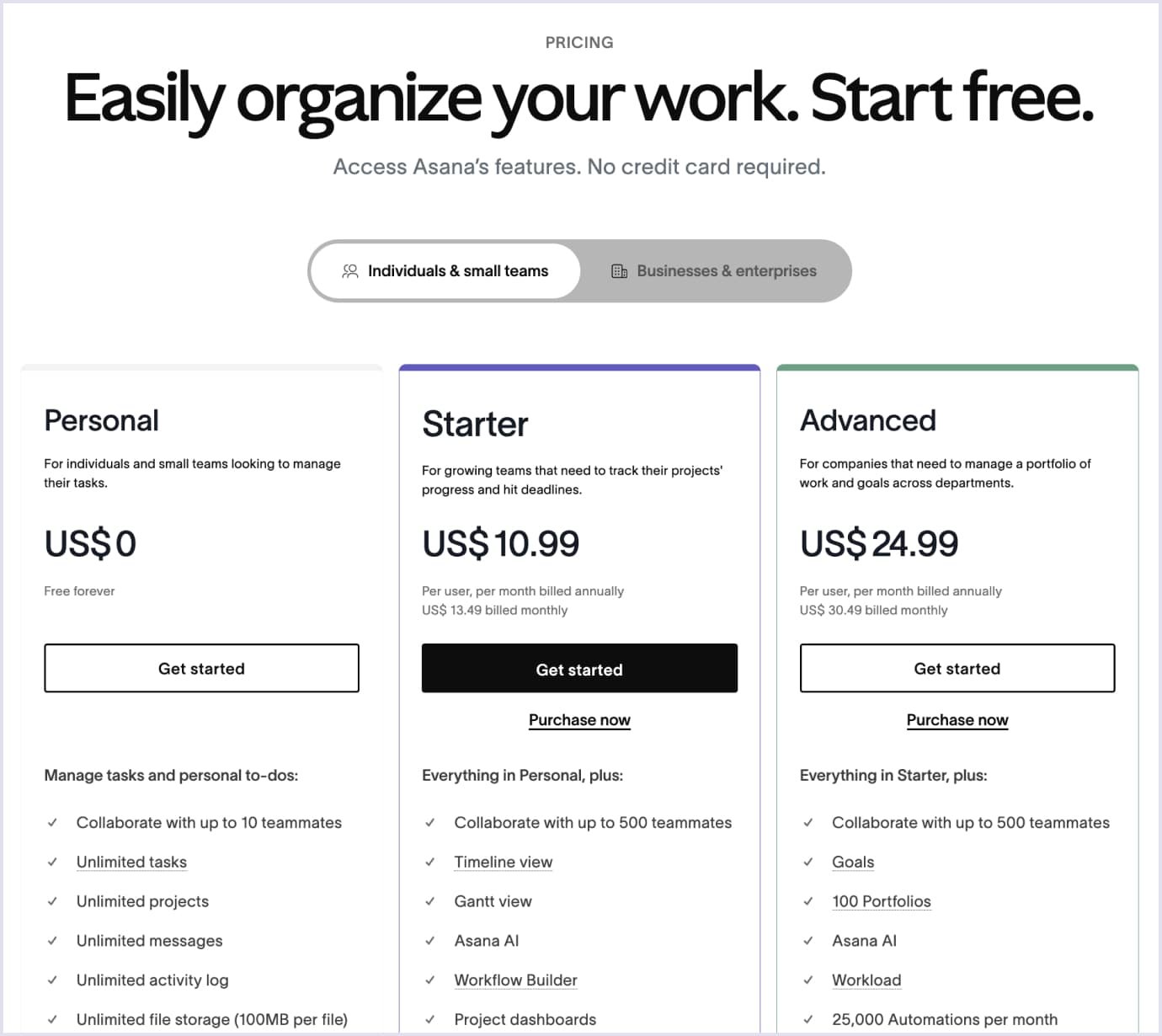
Source: Asana
As a rule, this SaaS pricing model comes together with a feature-based revenue strategy.
In simple terms, customers can pick the package based on the required features, and then you charge them per user.
Tiered pricing
This term means providing customers with several packages with different functionality for a different price. If the product you sell has various use cases, this is the best SaaS pricing model.
Pros
- You can appeal to several buyer personas with this pricing strategy for SaaS.
- Customers get the power of choice: they can pick the package that satisfies their business needs better.
- A SaaS company can maximize its revenue from each customer type by offering its product to multiple buyer personas.
Cons
- The diversity of packages can put users off their stride.
- You may consider offering many packages to suit every possible business need. However, you cannot be everything for everyone.
You may also like: SaaS Security Guide: How to Protect Your Product and User Data
Speaking of examples, a platform for marketing, sales, and customer service called Hubspot utilizes this SaaS pricing model. Below, you can see the different packages that Hubspot provides:
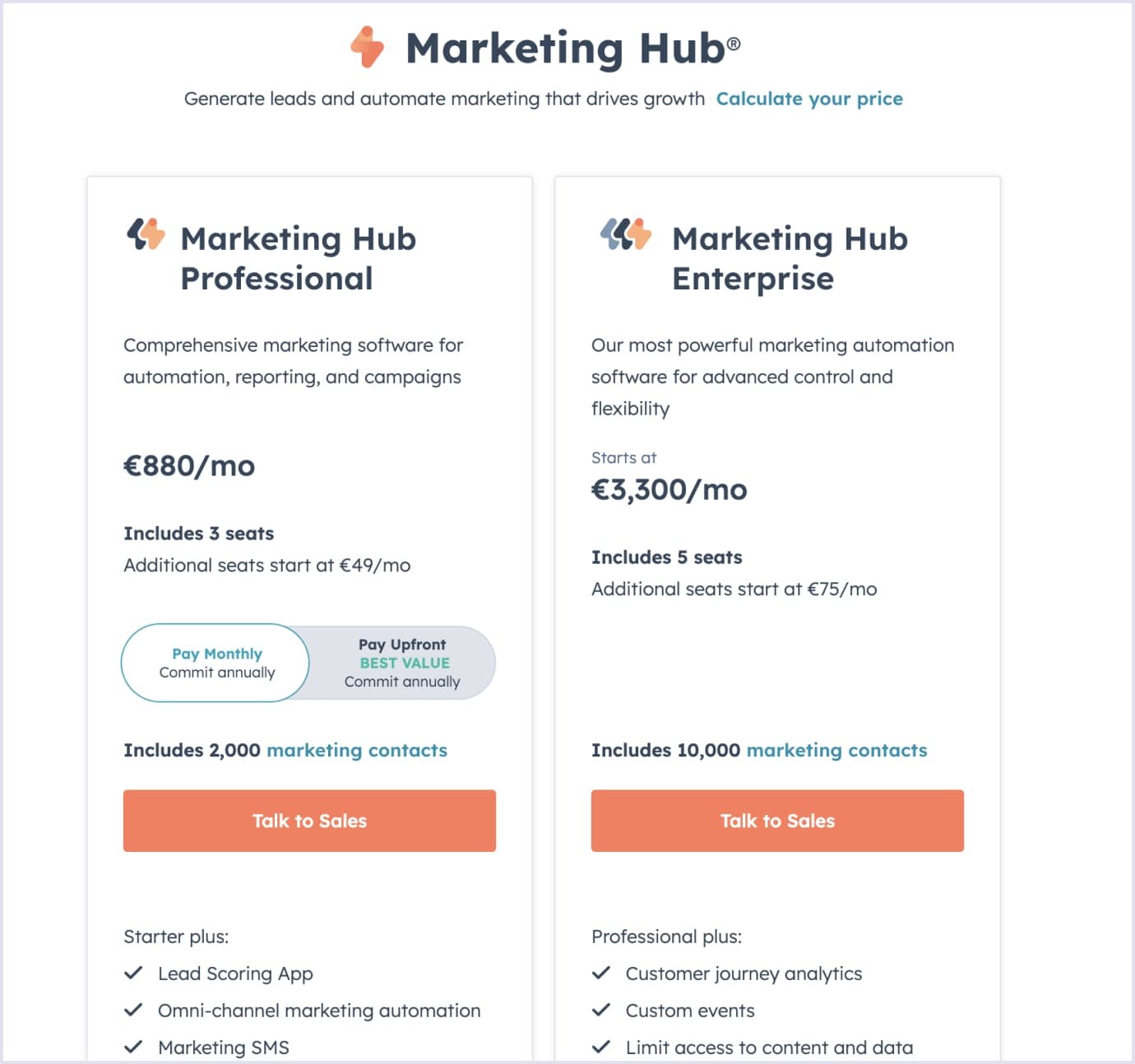
Source: Hubspot
Per-storage pricing
It is one of the simplest SaaS pricing models. The cost of the solution depends on the amount of storage space required.
You can follow the lead of popular SaaS companies like Google or Dropbox and offer a small amount of storage for free. As soon as customers hit their limit, they can choose a paid package. This is a great sales pitch since you allow them to get to know your product first.
Pros
- Customers often find this model the fairest and most transparent among all other SaaS pricing strategies. This is because the price they pay for cloud development services is directly proportional to the storage space they need.
- This software pricing model is flexible enough to adapt quickly to your customers’ business fluctuations.
Cons
- Predicting revenue is one of the challenges in SaaS pricing strategies. Your revenue depends solely on customers’ usage of your SaaS product and cannot be measured accurately.
- If you provide customers with enough free storage, they may never see the necessity to pay for a more expensive package.
See per storage SaaS pricing model example from Dropbox below:
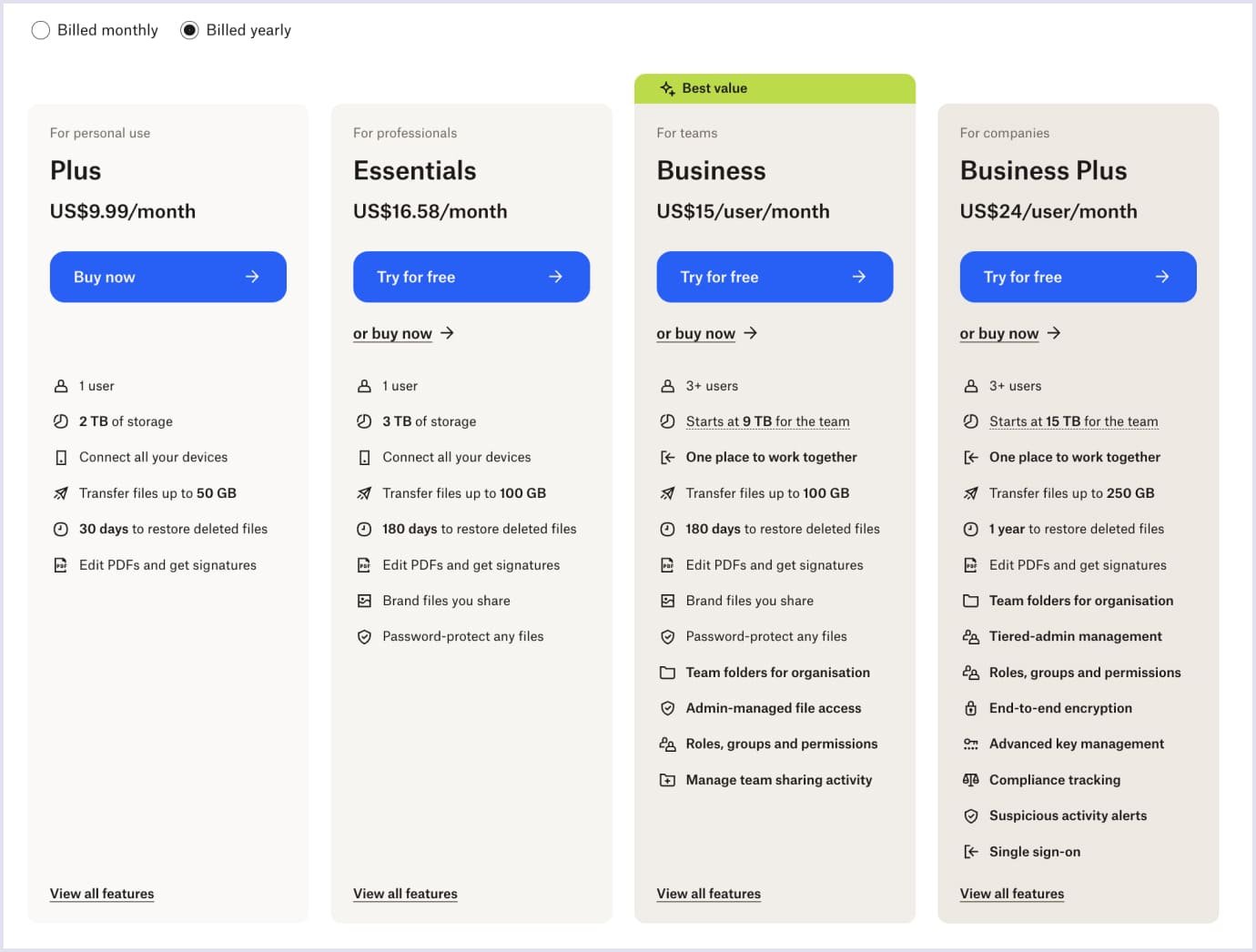
Source: Dropbox
Feature-based pricing
In this case, the price for your cloud solution is defined by the functionality available for your customers. The more features they need, the higher price they will have to pay.
Pros
- With feature-based SaaS pricing, consumers are motivated to upgrade their packages. This way, they will get extra functionality.
- If your SaaS product development is resource-consuming, you may charge customers premium prices for the most complex functionality,
- This SaaS pricing example is cost-effective for your clients since they do not have to pay for unnecessary features.
Cons
- It can be challenging for business-to-business (B2B) SaaS companies to predict what features consumers need more than others.
- Some customers may find this pricing strategy disappointing for SaaS companies. You can see the problem - they pay monthly fees but still cannot access the full functionality.
QuickBooks, the accounting software, provides customers with the following packages:
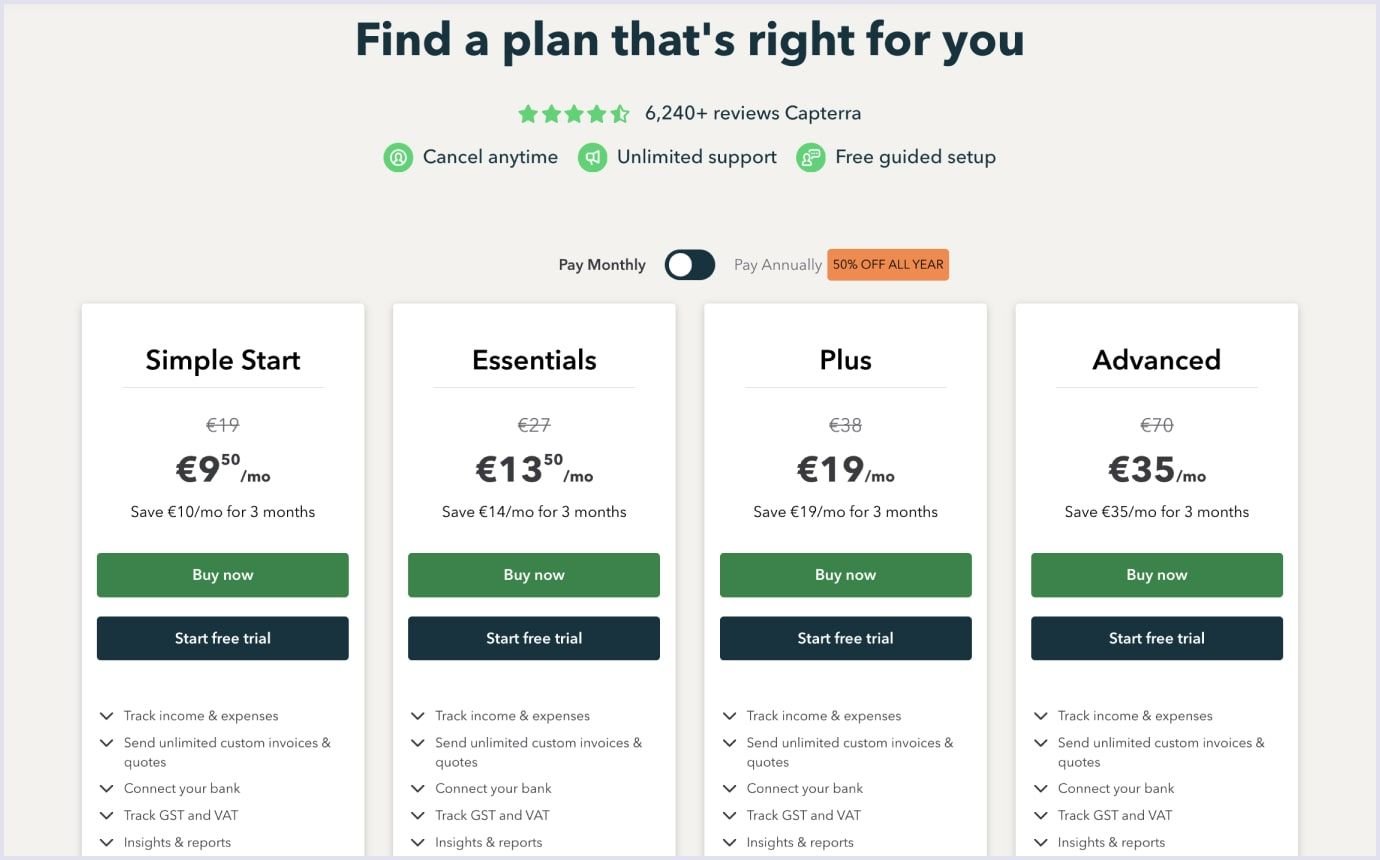
Source: QuickBooks
Pay As You Go
This software-as-a-service pricing model suggests charging customers based on the usage of your product. In a nutshell, the more customers use it, the higher your revenue will be. B2B SaaS companies offering infrastructure cloud products often adopt this pricing model.
You may also like: Choosing the Best SaaS Hosting Provider for Your SaaS App
Pros
- Consumers' barriers to entry are low. They can start by paying a small fee for a product. Then, you can gradually increase prices for those consumers who use it most frequently.
- SaaS business charges grow together with product usage. The popularity of your product increases your revenue.
Cons
- Power users may find the cost too high. Consequently, they may go to a competitor that adopted other SaaS pricing models (e.g., fixed monthly or yearly fee).
- Predicting revenue may be somewhat challenging. You cannot know exactly how much a particular consumer will use your product.
- At the same time, it can be difficult for customers to calculate the cost since they cannot forecast their resource usage.
As you can see below, CDN provider Bunny.net charges users based on the gigabytes of data served in a month.
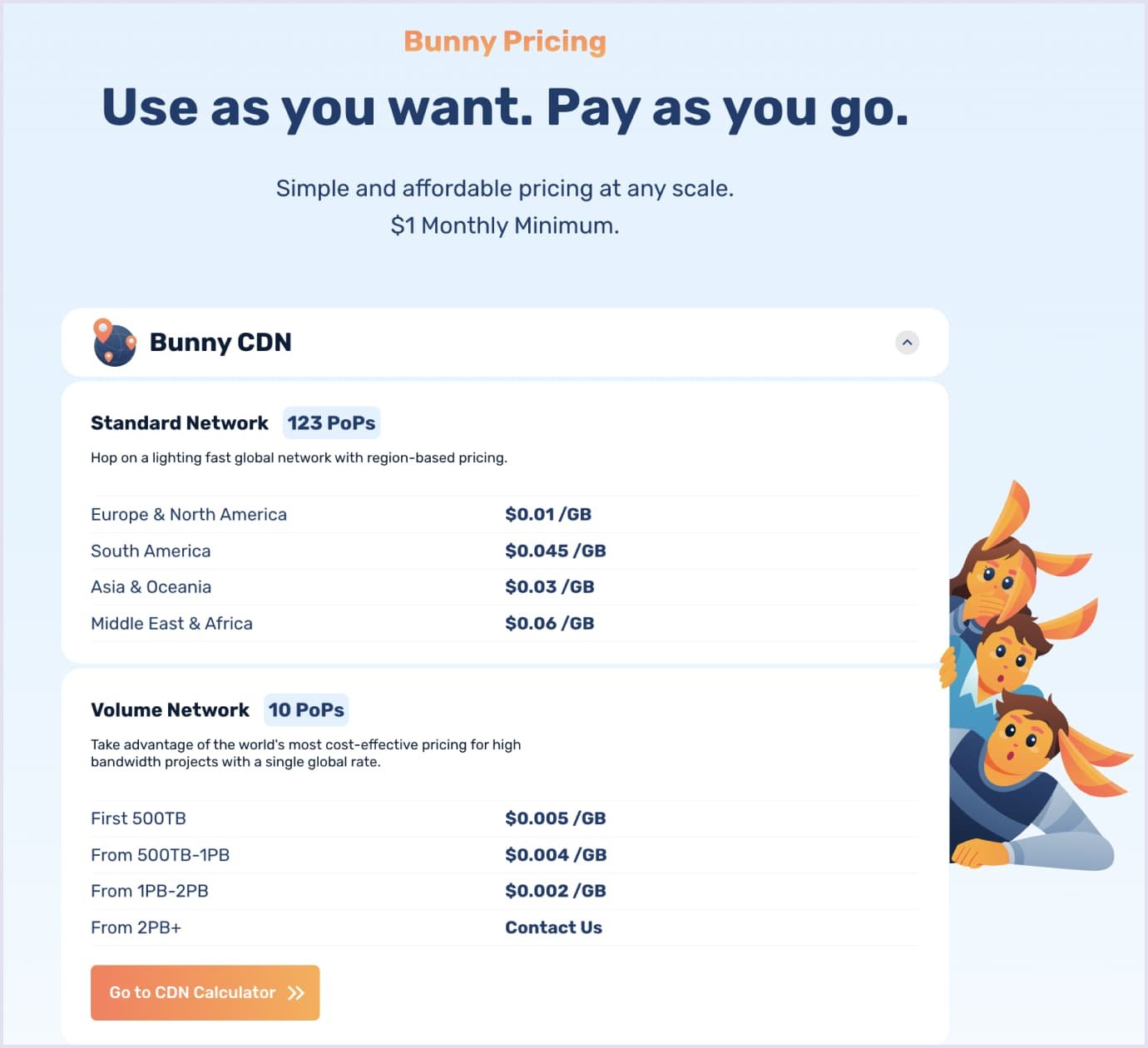
Source: Bunny.net
Freemium
Another great approach to SaaS pricing is to offer some free functionality. You can always supplement your free offering with additional paid packages. The freemium model works best when your add-on services bring real value to the customers.
Pros
- Adoption for customers is simple - it has never been easier to start using your SaaS product with this SaaS pricing strategy.
- The free version serves as a perfect testing ground for experimenting with new functionality.
Cons
- Statistics tell that less than 10% of free users become paid customers. It means an unwanted burden on your limited sources if you have more free customers than paid ones.
- Customers give up free products eagerly. In fact, customers tend to value those things that cost them a heavy price.
- In case users are not interested in switching to paid packages, this SaaS pricing example can kill your revenue.
See the available packages within the MailChimp B2B SaaS pricing model below:
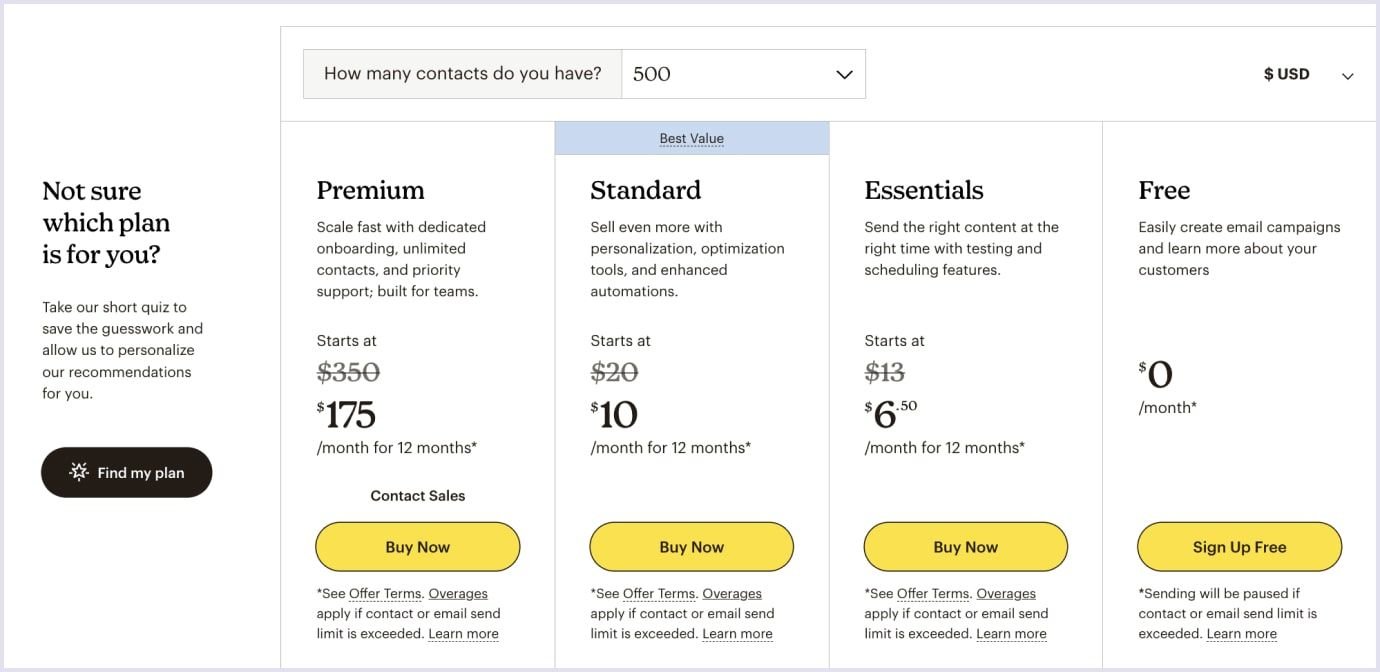
Source: Mailchimp
Flat pricing/subscription
It is probably the most straightforward option among all SaaS pricing models. There is only one product with a definite set of features that is sold for a single price.
Pros
- Customers can easily understand this pricing model for SaaS.
- Having one clearly defined product gives you more time for marketing and promotion.
- Brand-new SaaS startups can use this model to stand out from established competitors with complicated and tricky revenue strategies.
Cons
- You cannot get the maximum revenue from your diverse customer base. Both startups and established enterprises will be paying the same price for your services.
- Since you do not offer upgrade packages, you will miss upselling opportunities.
- It can be tough to engage different types of customers who have opposing opinions about pricing. Some users may want to pay for what they actually use instead of paying the total price for a product they might not like.
The classic example of the SaaS company using this strategy is Basecamp:
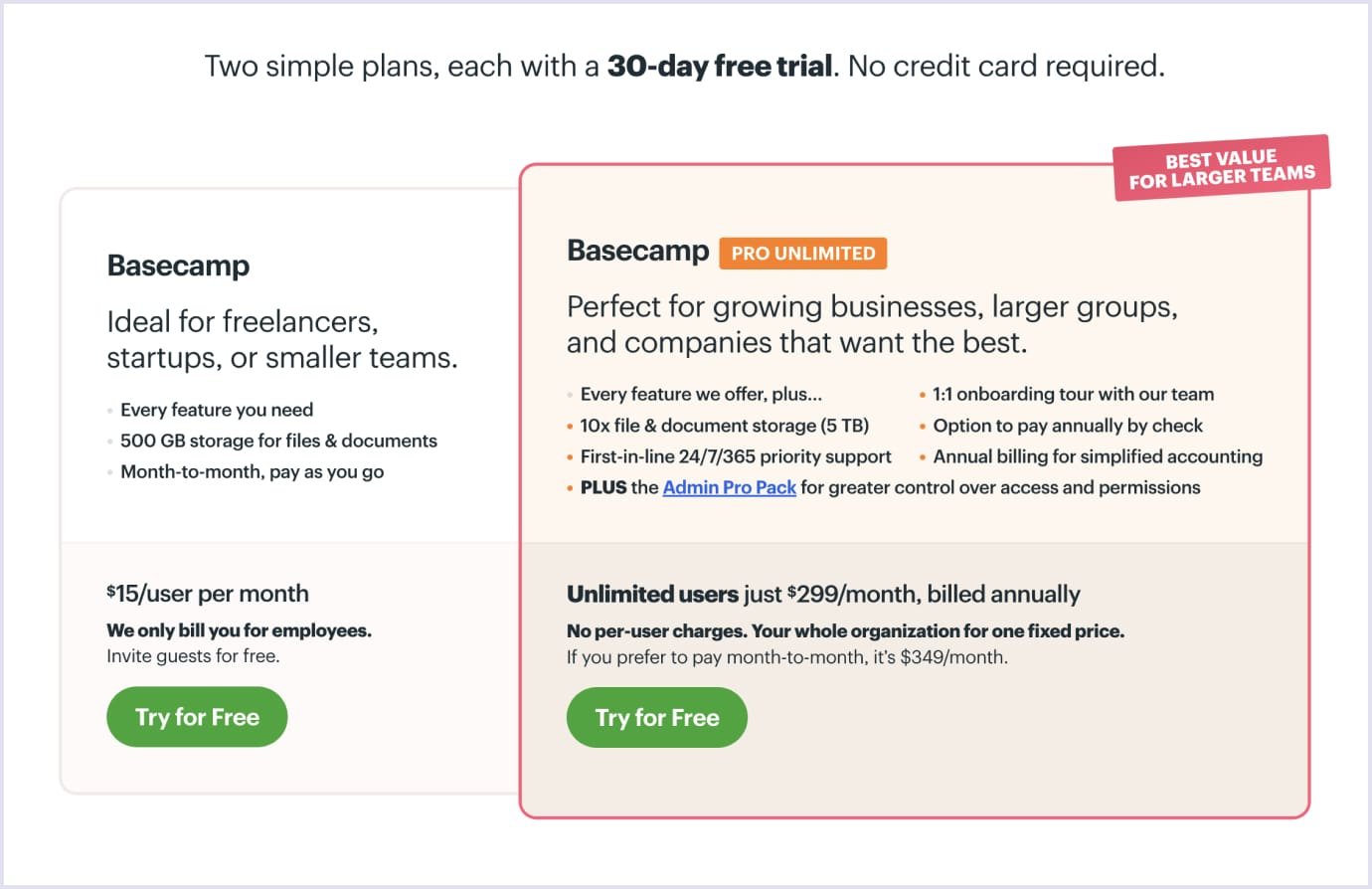
Source: Basecamp
By the way, did you know that Basecamp was built with Ruby on Rails?
Read also: SaaS Product Development: Why Choose Ruby on Rails Framework
Free (ads supported)
This software-as-a-service pricing model reminds the freemium one, however, monetization comes from ads. It works best if you offer a very consumer-centric SaaS product, and you have lots of free users you tend to monetize.
Pros
- It works well for software-as-a-service companies that offer customers a free option but still want to get revenue from those users.
- This SaaS pricing example suits you if you would like to adopt a freemium model but do not want to cut the available functionality. You can add advertisements to encourage customers to upgrade.
Cons
- Intrusive ads can hurt user experience and, as a result, your brand.
- You will have to hire specialists responsible for ad selling.
With Spotify's Premium SaaS price model, users can listen to music without ads.
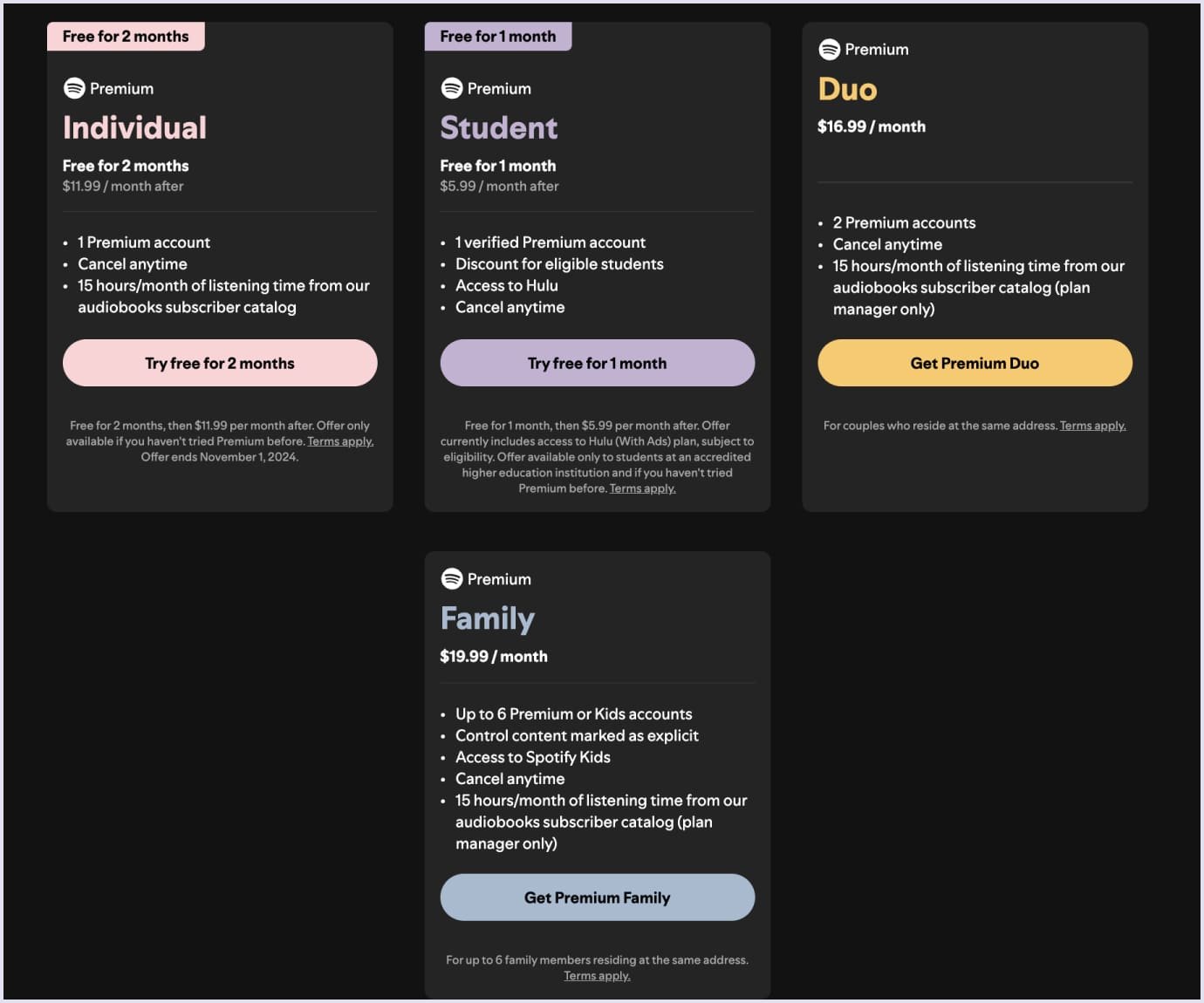
Source: Spotify
Credit-based pricing
Sometimes, a customer wants to use a specific service but is unsure when and to what extent. In this case, the credit-based SaaS pricing model is the best.
With this approach, a user pays for a specific unit of products or services. If the needs increase, the user will purchase additional credits. The main peculiarity of this model is that a customer is charged before using a package of products or services.
Pros
- Users don’t worry about when to use the unit they paid for.
- The model allows the SaaS provider to obtain cash flow as users pay before using the service.
Cons
- Users may request a credit refund if they don’t use a feature regularly.
- If users accumulate many credits, they may stop using the service altogether.
A quite simple yet effective implementation of this model can be seen on OpenAI with its API services.
In their pricing model, users purchase "credits" to access different levels of API usage based on the amount and type of compute resources needed (e.g., text generation, fine-tuning models, etc.). The number of credits consumed varies depending on the request's complexity, such as model size or output length.
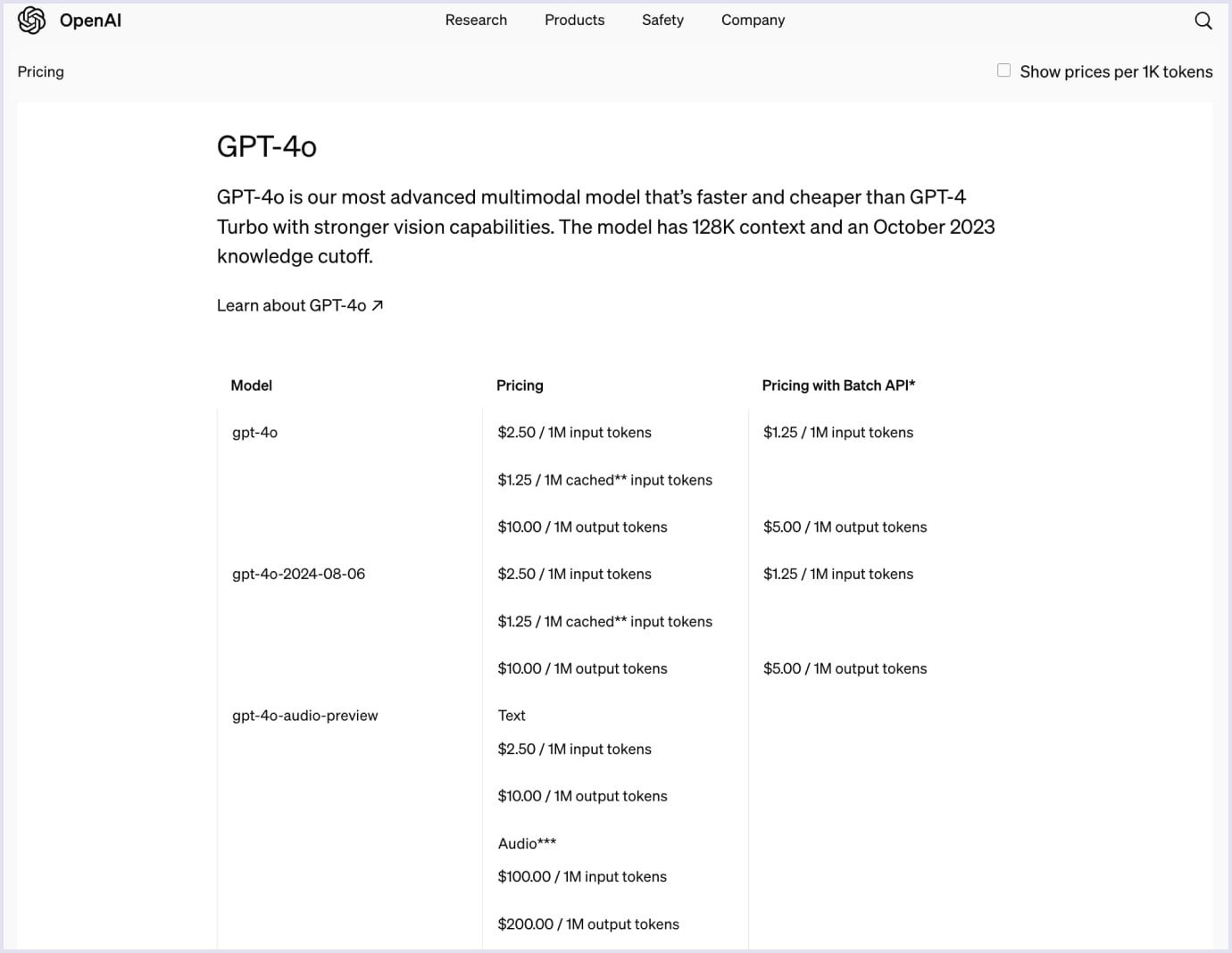
Source: OpenAI
Hybrid pricing
Some platforms have many products, making it challenging to include all features in one pricing model. Therefore, companies apply many pricing models for their SaaS services.
For example, one of the most popular combinations is flat-rate and usage-based pricing. It allows users to get specific features at a fixed price.
Pros
- The model employs fair ways of charging depending on users’ needs.
- There are limitless opportunities to expand the audience, offering users different pricing options.
Cons
- This pricing model becomes challenging quickly.
- A company needs complex management of SaaS hybrid pricing models to see the perspectives of their cash flows.
As you can see below, Vimeo offers the following plans for creating videos and other services:
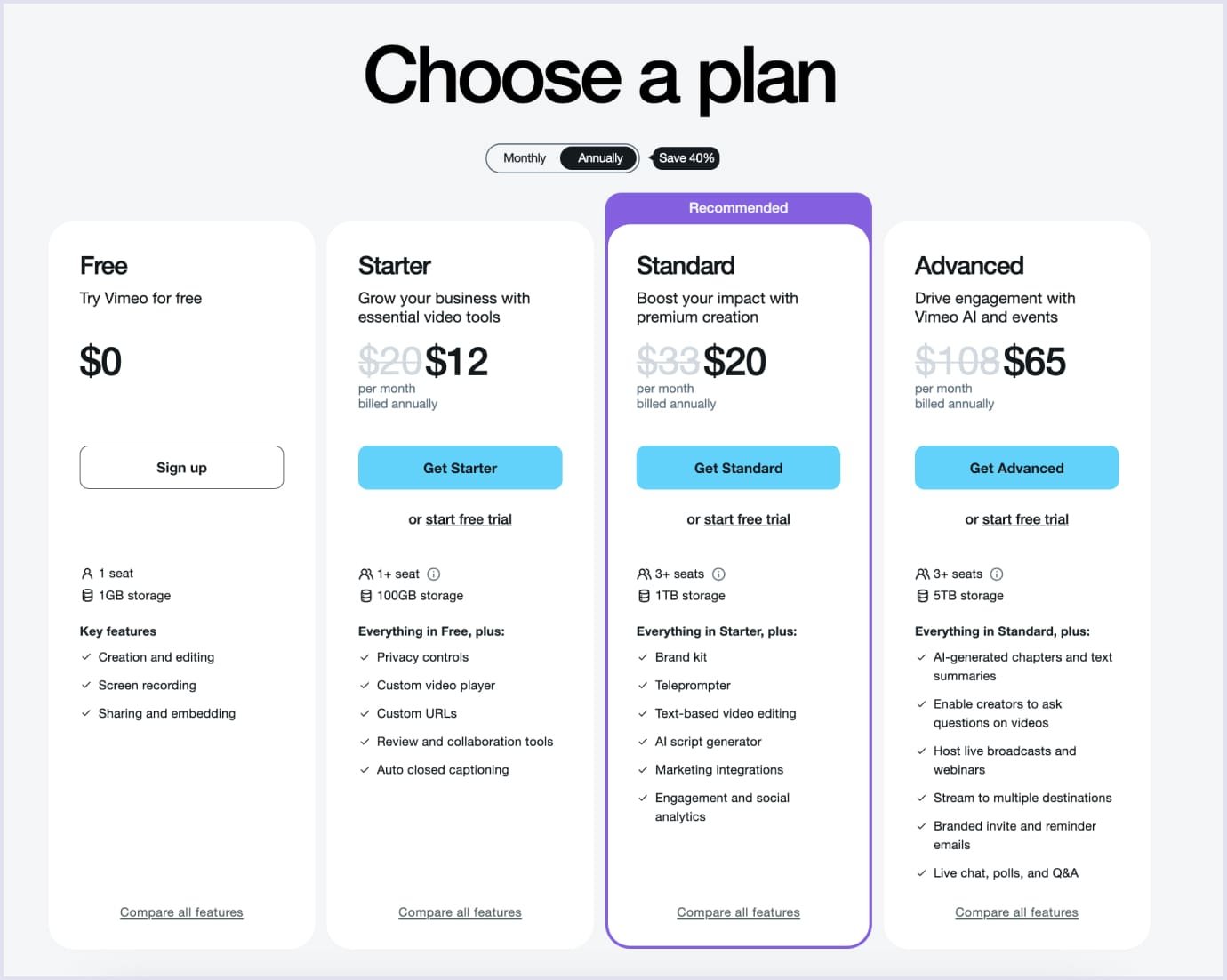
Source: Vimeo
Be aware that choosing a suitable revenue model is vital for any business, not just SaaS companies.
Psychological pricing tactics
Your work does not end with choosing the appropriate SaaS pricing models. You need to improve your SaaS price off and on to stay relevant.
That’s when psychological SaaS pricing strategies can save the day. Consider them as creative experiments for optimizing and fine-tuning your revenue model.
Below, we have picked several SaaS revenue models that you should also consider:
- Charm pricing: this term refers to the prices that end in number nine.
- Odd-even pricing: this SaaS pricing example is somewhat similar to the previous one. You reduce the price by a few dollars to get it closer to the so-called “rounded” price point.
- Product bundle pricing: it means providing consumers with a free package for a single price.
- High-low pricing: B2B SaaS businesses alter between high and low prices. At first, you offer your SaaS product at a premium price, then reduce it to a lower one.
- Trial pricing: this model suggests selling your product at a discounted price for a limited time.
- Center-stage pricing: you offer three different packages. Consumers may consider the middle solution a safer bet than the cheapest and most expensive options.
- Decoy pricing: some software-as-a-service companies add a less-than-desirable option to encourage users to choose one of the remaining solutions.
Further reading: How to Build a SaaS Startup in 10 Smart Steps
How to choose the right SaaS pricing strategy
As you can see, there are plenty of SaaS pricing models to pick from. Your task is to define which option is the right solution for your business.
The steps below will help you make the right choice.
Step 1. Analyse market research data
As soon as you come up with an idea of creating a SaaS product, you need to conduct market research. This way, you can test the feasibility of your venture.
What is more important, you will get useful insights into your target audience. When you learn about your potential customers, you will know what solution to offer them. Also, you will find out what pricing strategy you should choose for SaaS.
Decide what consumers you want to attract. Are you going to gain as many consumers as possible? Or will you focus on the most prominent clients that will profit you more?
Step 2. Define the value for the customer
You may think that the specific functionality of your product brings your customers the highest value.
In fact, users appreciate the ability to fix their issues with your SaaS solution the most. So, you need to understand their pain points to provide excellent customer service.
Besides, it will help you define your product’s actual value and, thus, get the differential advantage.
Step 3. Clarify your market position
Your next step is to define your position in the market. For this purpose, conduct a market analysis. Define the most prominent industry players, their merits, and flaws. What SaaS pricing strategies do they use? Think carefully about where you can do better than them.
Besides, it would be a great idea to carry out a SWOT (Strengths, Weaknesses, Opportunities, Threats) analysis. This approach will give you insights into your SaaS business's strengths and weaknesses. In addition, you will know what threats and hidden opportunities your industry is associated with.
Step 4. Choose the right metrics
Thus, you can determine which SaaS pricing models suit your customers best.
Suppose you provide consumers with storage. Your metric should be storage capacity. As for SaaS pricing strategies, the per-storage pricing model will work best in this case.
Other widespread SaaS metrics include price by functionality, user, or tier SaaS pricing.
Step 5. Define the deal
You have chosen the pricing strategy for SaaS and the key metrics. Now, it is time to define your deal.
Will your consumers pay for one plan? Will there be several different packages? Will customers be able to upgrade?
Step 6. Calculate the customer lifetime value metric
It would be a sound idea to measure customer lifetime value. You need this data to find out what revenue you will get from an average customer over the whole time they have been using your product.
Thus, you will understand whether this revenue model will work for you or whether you will need to consider other SaaS pricing strategies.
You may calculate this figure easily. The formula looks the following way where ARPU stands for average monthly revenue per user:
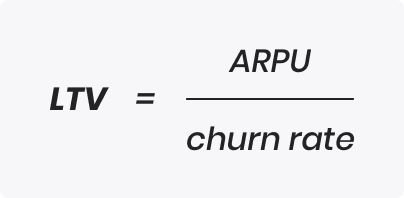
Step 7. Define the value of free trials
Offering a free trial only makes sense if customers see the SaaS product's value when the trial is over. If you notice that consumers using a free trial do not convert into paying customers, try conducting a feature audit. Find out what functionality satisfies customers and add it to your free trial.

Conclusion
We hope our guide on SaaS pricing models will be helpful for you. We have discussed plenty of SaaS pricing strategies and hope you can choose the right one. Don’t forget to revise your pricing from time to time. Thus, you can stay in the game and grow your software-as-a-service business.
If you are considering building a SaaS application, feel free to contact us. Our expert team would gladly deliver a flexible and secure cloud solution for you.

